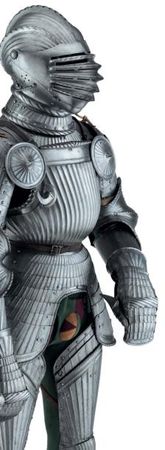Belle et rare armure à cannelures dite « Maximilienne », globalement Allemagne du Sud vers 1525-30
Belle et rare armure à cannelures dite « Maximilienne », globalement Allemagne du Sud vers 1525-30. Photo Pierre Bergé & associés
A fine and rare South German fluted full armour in the "Maximilian" fashion, comprehensively circa 1525-30.
Comprising close helmet with one-piece skull drawn-up to a cabled comb in the middle, with an additional comb, lower, left and right, almost all of the remaining surface embossed with four bands of flutes extending from an incised line at the nape and converging over the face-opening, pierced with six pairs of lace holes over the rear, the base of the skull and the base of the bevor boldly flanged as though to turn on the gorget, the rounded flange very unusually extended around its lower edges to attach a pair of fluted neck-plates front and rear, the lower edges boldly turned and roped, the roping matching that of the upper flange, the skull studded with lining rivets at the rear and with further flush-fitting rivets around the face-opening, pivoted bevor formed with a prominent chin, the sides recessed for the visor, pierced with circular holes at the ears and locked by a spring-catch on the right, an additional spring-catch locking the visor, the bevor studded with lining rivets and fitted with later arm supporting the visor, and associated visor of bellows type pivoting at the same points as the bevor and now formed with two pairs of sights arranged in tiers, gorget of four plates front and rear, hinged on the left and closed on the right, the upper plates turned and roped, the lower three plates embossed with fan-like arrangements of narrow flutes widening progressively towards the base front and rear, and the sides each now with three drilled holes and corresponding hooks for fitting a modern crescentic plate over the top of each shoulder, these in turn each carrying a modern fluted beseague, breast-plate and matching back-plate each struck with Nuremberg mark on the inside towards the top, N in a pearled circle, the breast-plate of globose form embossed with broad flutes over the greater part of its surface, the fluting terminating below a single horizontal flute towards the top, the upper edge cut straight and formed with a prominent roped flanged turn, the arm-gussets en suite, fitted with associated waist-lame and later lance-rest, retaining a period skirt of three lames, almost certainly the original and a pair of short tassets each of four lames and matching the skirt and the cuirass, the back-plate fitted with waist-plate incised with double linear bands and retaining its original skirt of two lames, a pair of composed full arm defences, the spaulders and the lower-cannons matching the main elements of the armour, the couters associated, the spaulders each formed of six plates moving on internal leathers and sliding rivets, with no provision for turners, the lower-cannons each with hinged inner plate, the double fluted borders matching those of the spaulders, the skirt lames, the tassets and the cuisses and poleyns, with couters of accentuated proportions and strongly embossed over the point of the elbows, a pair of mitten-gauntlets, the cuffs each struck with Nuremberg mark an armourer's mark (rubbed), fluted metacarpus of four lames, the lower lame of each embossed for the ulna, one retaining the original diagonally fluted bar over the knuckles and the other retaining the original mitten-lames, (the inner cuff plates, the thumb lames and one set of mitten lames all restored), a pair of full leg defences with cuisses each with two articulated lames at the top, poleyns each of five lames, the side wings additionally decorated at their stem with a pair of rear-curled projections in the manner of fleur-de-lys, and with a pair of modern greaves and articulated "bearpaw" sabatons intended to match the armour, the heels carrying a pair of rowelspurs also in 16th century style, the armour studded with domed iron rivets and the principal elements with turned roped edges: on a purpose-built fabriccovered mannequin with sculpted mask.
H.: 170 cm - Wt.: 18.170 kg. Résultat : 70 000 €
The full and close-set treatment of the fluting is representative of the so-called Maximilian style at almost its most developed stage. The circular Nuremberg mark stamped on the inside of the breast-and back-plates was the mark of officials of the Nuremberg hammermill. The Nuremberg mark struck on the gauntlets is that of the arms of the city of Nuremberg, the proof mark of the Armourers' guild. The close helmet on the present armour is distinguished by the highly unusual addition of a pair of neck-lames; these are riveted to the internal flange which encircles the base of the boldly roped flange beneath the nape and the chin. This arrangement would appear to have only a single precedent, the helmet on armour A26 in the Wallace Collection, London. Both the 1962 catalogue and the 1986 supplementary catalogue offer no comment on this feature. The additional neck lames on the two helmets in question are certainly original to each. In the absence of any further explanation it would seem that their inclusion in conjonction with the counterfeit gorget flange is no more than a mark of stylistic individuality expressed by the armourer.
See MANN, James, Wallace Collection Catalogues, European Arms & Armour, vol. I, 1962, No. A26, pp.23-25, plate 70.
Pierre Bergé & associés. Mardi 13 décembre à 15h00. Grand Sablon 40 Grote Zavel, Bruxelles. « Le musée fantastique » de Karsten Klingbeil armes et armures anciennes. EMail : contact@pba-auctions.com - Tél. : Paris +33 (0)1 49 49 90 00 - Bruxelles + 32 (0)2 504 80 30

/https%3A%2F%2Fprofilepics.canalblog.com%2Fprofilepics%2F1%2F0%2F100183.jpg)
/https%3A%2F%2Fstorage.canalblog.com%2F03%2F02%2F119589%2F96711876_o.jpg)
/https%3A%2F%2Fstorage.canalblog.com%2F11%2F31%2F119589%2F94773502_o.jpg)
/https%3A%2F%2Fstorage.canalblog.com%2F20%2F83%2F119589%2F94772815_o.jpg)
/https%3A%2F%2Fstorage.canalblog.com%2F26%2F72%2F119589%2F75604929_o.jpg)
/https%3A%2F%2Fstorage.canalblog.com%2F59%2F60%2F119589%2F26458628_o.jpg)






/image%2F1371349%2F20240425%2Fob_c453b7_439605604-1657274835042529-47869416345.jpg)
/image%2F1371349%2F20240425%2Fob_59c6f0_440358655-1657722021664477-71089985267.jpg)
/image%2F1371349%2F20240425%2Fob_07a28e_440353390-1657720444997968-29046181244.jpg)
/image%2F1371349%2F20240425%2Fob_0b83fb_440387817-1657715464998466-20094023921.jpg)